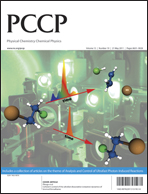Laser-induced alignment and anti-alignment of rotationally excited molecules
Abstract
We numerically investigate the post-pulse alignment of rotationally excited diatomic molecules upon nonresonant interaction with a linearly polarized laser pulse. In addition to the simulations, we develop a simple model which qualitatively describes the shape and amplitude of post-pulse alignment induced by a laser pulse of moderate power density. In our treatment we take into account that molecules in rotationally excited states can interact with a laser pulse not only by absorbing energy but also by stimulated emission. The extent to which these processes are present in the interaction depends, on the one hand, on the directionality of the molecular angular momentum (given by the M quantum number), and on the other hand on the ratio of transition frequencies and pulse duration (determined by the J number). A rotational wave packet created by a strong pulse from an initially pure state contains a broad range of rotational levels, over which the character of the interaction can change from non-adiabatic to adiabatic. Depending on the laser pulse duration and amplitude, the transition from the non-adiabatic to the adiabatic limit proceeds through a region with dominant rotational heating, or alignment, for short pulses and a large region with rotational cooling, and correspondingly preferred anti-alignment, for longer pulses.

- This article is part of the themed collection: Analysis and Control of Ultrafast Photon-Induced Reactions

 Please wait while we load your content...
Please wait while we load your content...